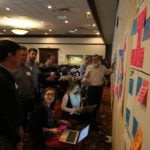Priority-based quarterly planning
Three hundred team members from across BBVA Compass spent two days last week reviewing the previous quarter’s accomplishments and prepping the road ahead for 35 of the bank’s most important projects.

The so-called Quarterly Planning sessions use agile methodology to set product and development priorities in three-month increments. The outcome includes realistic project plans that have identified the most important priorities, planned for and mitigated roadblocks, and aligned all areas across the bank toward their specific tasks to ensure rapid execution.
According to BBVA Compass Chief Information Officer Gabriel Sánchez Iniesta, the planning sessions may look chaotic to the untrained eye, but the results speak for themselves.
“This is our fourth planning meeting, so the teams are synchronized,” he said. “The beauty of this process is how it ensures that we are working on projects that are aligned to our strategic priorities across departments, which allows us to work more efficiently, make key decisions quickly and work across teams, without silos.”
The beauty of this process is how it ensures that we are working on projects that are aligned to our strategic priorities across departments
How does it work?
During the planning session, teams leading projects huddle to prioritize their initiatives, known as epics, for the next quarter. As part of the process, they think through specific tasks -- these are dubbed “dependencies” -- for each epic that may require input from support departments, like Legal or Marketing. These tasks are then taken to representatives of those departments for prioritization.

What’s with the big white pieces of paper that are covered in blue, orange and pink sticky notes?
The white papers represent specific projects or teams, while the sticky notes placed on each are the project’s agreed upon epics or dependencies.
The blue sticky notes on the white paper denote an initiative (epic) within the project while the pink and orange notes identify tasks (dependencies) that the support departments need to complete for the initiative. The pink sticky notes stay on the project team’s white paper, while the orange notes are given to the support department whose job it is to carry out the specific task.
The sticky notes are a visual representation of the total team project.

It seems like the support departments might end up with a lot of dependencies, like the Legal department for instance. What happens if there are conflicts or competing priorities?
The portfolio management team -- in part comprised of Olalla and Sánchez Iniesta -- will work with the teams to help eliminate any roadblocks, but Pepe Olalla, head of BBVA Compass Business Development, says the goal is to always have a plan that is accurate and realistic. Whatever the teams commit to doing over the course of three months needs to be possible.
What has been the biggest accomplishment to come from these meetings?
Sánchez Iniesta says that the Quarterly Meetings have been key to shifting the mindset of team members across the bank. The teams coalesce around a common goal related to the top priorities of the bank, and anything that doesn’t dial into those priorities is sloughed off. Put simply, “If it’s not related to the priorities, we don’t do it,” Sánchez Iniesta said.
To hear more about some of the previous quarter’s accomplishments, view the Quarterly Planning video here.